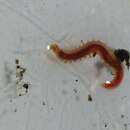en
names in breadcrumbs


Armandia brevis is an undulatory burrowing opheliid polychaete found in surficial heterogeneous sediments (muds) (Dorgan et al., 2013). Its fast, energetic undulatory behavior is superficially similar to undulatory behavior exhibited by nematodes. A. brevis also exhibits swimming behavior, particularly during the spawning phase of its life cycle.
A. brevis has a smooth, rigid body with ventral and lateral grooves extending along the entire elongated body. Internally, A. brevis has longitudinal and oblique muscles, but lacks circular muscles (Clark and Hermans, 1976; Law et al., 2014).
Armandia brevis is an undulatory burrowing opheliid polychaete found in surficial heterogeneous sediments (muds) (Dorgan et al., 2013). Its fast, energetic undulatory behavior is superficially similar to undulatory behavior exhibited by nematodes. A. brevis also exhibits swimming behavior, particularly during the spawning phase of its life cycle.
A. brevis has a smooth, rigid body with ventral and lateral grooves extending along the entire elongated body. Internally, A. brevis has longitudinal and oblique muscles, but lacks circular muscles (Clark and Hermans, 1976; Law et al., 2014).
Undulating movements of Armandia brevis resemble those of nematodes both in qualitative behavior and in body shape, characterized by the ratio of amplitude to wavelength (Dorgan et al., 2013). Like nematodes, A. brevis has thick bands of longitudinal muscle that contract unilaterally for undulatory bending. Bending during undulatory burrowing requires unilateral contraction of longitudinal muscles simultaneously with a mechanism to resist radial expansion and axial shortening on the side of muscle contraction. As the wave of contraction passes posteriorly, longitudinal muscles on the non-bending side contract, extending the contracted longitudinal muscles and serving as a restoring force. The contracted oblique muscles presumably also extend when the body reaches the opposite curvature, although contraction of the ventral longitudinal muscle would likely extend relaxed oblique muscles as well (Law et al., 2014).
Undulatory Burrowing
Many macrofaunal burrowers found in muddy sediments exhibit peristaltic behavior and use eversible mouthparts or anterior regions to apply dorso-ventral forces to burrow walls and extend the burrow by fracture (Dorgan et al., 2005). Armandia brevis, however, lacks both circular muscles and an expansible anterior necessary for peristalsis (Dorgan et al., 2013). Instead, A. brevis exhibits undulatory movements; however, unlike other undulatory burrowers that fluidize sediments—such as the sandfish lizard—A. brevis plastically rearranges sediment grains to create a burrow (Dorgan et al., 2013). This mechanism is likely limited to uncompacted, surface sediments, consistent with habitat descriptions for A. brevis.
Swimming Behavior
A. brevis also exhibits swimming behavior, the only member of its own subfamily Ophelininae to exhibit this behavior (Hermans, 1978). Though dispersal is another explanation, most swimming A. brevis are reproductive, swimming towards the surface during summer nights to release gametes. Spawning occurs only once before death (Hermans, 1978).
A. brevis has a smooth, rigid body with ventral and lateral grooves extending along the entire elongated body (Clark and Hermans, 1976).
Internally, large dorsal and ventral longitudinal muscle bands are the prominent musculature in Armandia brevis, lying directly beneath the epidermis. The ventral longitudinal muscles form two well-developed ventral bundles that shape the ridges of the ventral groove and are separated by the ventral nerve cord. The dorsal longitudinal muscle bands become thinner mid-dorsally but do not separate completely. No circular muscle fibers are found between the epidermis and longitudinal muscles, but four bands of oblique muscle occur per segment. Oblique muscle bands extend from just dorsal of the ventral nerve cord and attach to the lateral epidermis between the dorsal and ventral longitudinal muscles (Law et al., 2014).
Only two septa occur in A. brevis, just posterior to the pharynx; the remaining body cavity is undivided by septa, allowing coelomic fluids to flow freely during body movements (Law et al., 2014).